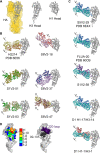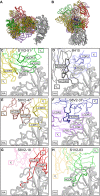A Prevalent Focused Human Antibody Response to the Influenza Virus Hemagglutinin Head Interface
- PMID: 34060327
- PMCID: PMC8262862
- DOI: 10.1128/mBio.01144-21
A Prevalent Focused Human Antibody Response to the Influenza Virus Hemagglutinin Head Interface
Abstract
Novel animal influenza viruses emerge, initiate pandemics, and become endemic seasonal variants that have evolved to escape from prevalent herd immunity. These processes often outpace vaccine-elicited protection. Focusing immune responses on conserved epitopes may impart durable immunity. We describe a focused, protective antibody response, abundant in memory and serum repertoires, to a conserved region at the influenza virus hemagglutinin (HA) head interface. Structures of 11 examples, 8 reported here, from seven human donors demonstrate the convergence of responses on a single epitope. The 11 are genetically diverse, with one class having a common, IGκV1-39, light chain. All of the antibodies bind HAs from multiple serotypes. The lack of apparent genetic restriction and potential for elicitation by more than one serotype may explain their abundance. We define the head interface as a major target of broadly protective antibodies with the potential to influence the outcomes of influenza virus infection. IMPORTANCE The rapid appearance of mutations in circulating human influenza viruses and selection for escape from herd immunity require prediction of likely variants for an annual updating of influenza vaccines. The identification of human antibodies that recognize conserved surfaces on the influenza virus hemagglutinin (HA) has prompted efforts to design immunogens that might selectively elicit such antibodies. The recent discovery of a widely prevalent antibody response to the conserved interface between two HA "heads" (the globular, receptor-binding domains at the apex of the spike-like trimer) has added a new target for these efforts. We report structures of eight such antibodies, bound with HA heads, and compare them with each other and with three others previously described. Although genetically diverse, they all converge on a common binding site. The analysis here can guide immunogen design for preclinical trials.
Keywords: X-ray crystallography; conserved epitope; human antibody repertoire; influenza vaccines.
Figures




Similar articles
-
A protective and broadly binding antibody class engages the influenza virus hemagglutinin head at its stem interface.mBio. 2025 Jun 11;16(6):e0089225. doi: 10.1128/mbio.00892-25. Epub 2025 May 20. mBio. 2025. PMID: 40391889 Free PMC article.
-
Mapping of a Novel H3-Specific Broadly Neutralizing Monoclonal Antibody Targeting the Hemagglutinin Globular Head Isolated from an Elite Influenza Virus-Immunized Donor Exhibiting Serological Breadth.J Virol. 2020 Feb 28;94(6):e01035-19. doi: 10.1128/JVI.01035-19. Print 2020 Feb 28. J Virol. 2020. PMID: 31826999 Free PMC article.
-
Influenza Virus Hemagglutinin Stalk-Specific Antibodies in Human Serum are a Surrogate Marker for In Vivo Protection in a Serum Transfer Mouse Challenge Model.mBio. 2017 Sep 19;8(5):e01463-17. doi: 10.1128/mBio.01463-17. mBio. 2017. PMID: 28928215 Free PMC article.
-
Next-Generation Influenza HA Immunogens and Adjuvants in Pursuit of a Broadly Protective Vaccine.Viruses. 2021 Mar 24;13(4):546. doi: 10.3390/v13040546. Viruses. 2021. PMID: 33805245 Free PMC article. Review.
-
Influenza Hemagglutinin Structures and Antibody Recognition.Cold Spring Harb Perspect Med. 2020 Aug 3;10(8):a038778. doi: 10.1101/cshperspect.a038778. Cold Spring Harb Perspect Med. 2020. PMID: 31871236 Free PMC article. Review.
Cited by
-
Immune memory shapes human polyclonal antibody responses to H2N2 vaccination.Cell Rep. 2024 May 28;43(5):114171. doi: 10.1016/j.celrep.2024.114171. Epub 2024 May 7. Cell Rep. 2024. PMID: 38717904 Free PMC article.
-
An Immunoproteomic Survey of the Antibody Landscape: Insights and Opportunities Revealed by Serological Repertoire Profiling.Front Immunol. 2022 Feb 1;13:832533. doi: 10.3389/fimmu.2022.832533. eCollection 2022. Front Immunol. 2022. PMID: 35178051 Free PMC article. Review.
-
An explainable language model for antibody specificity prediction using curated influenza hemagglutinin antibodies.bioRxiv [Preprint]. 2023 Sep 14:2023.09.11.557288. doi: 10.1101/2023.09.11.557288. bioRxiv. 2023. Update in: Immunity. 2024 Oct 8;57(10):2453-2465.e7. doi: 10.1016/j.immuni.2024.07.022. PMID: 37745338 Free PMC article. Updated. Preprint.
-
Influenza A Virus H7 nanobody recognizes a conserved immunodominant epitope on hemagglutinin head and confers heterosubtypic protection.Nat Commun. 2025 Jan 9;16(1):432. doi: 10.1038/s41467-024-55193-y. Nat Commun. 2025. PMID: 39788944 Free PMC article.
-
Primary antibody response after influenza virus infection is first dominated by low-mutated HA-stem antibodies followed by higher-mutated HA-head antibodies.Front Immunol. 2022 Nov 3;13:1026951. doi: 10.3389/fimmu.2022.1026951. eCollection 2022. Front Immunol. 2022. PMID: 36405682 Free PMC article.
References
-
- Whittle JR, Zhang R, Khurana S, King LR, Manischewitz J, Golding H, Dormitzer PR, Haynes BF, Walter EB, Moody MA, Kepler TB, Liao HX, Harrison SC. 2011. Broadly neutralizing human antibody that recognizes the receptor-binding pocket of influenza virus hemagglutinin. Proc Natl Acad Sci USA 108:14216–14221. doi:10.1073/pnas.1111497108. - DOI - PMC - PubMed
-
- Ekiert DC, Kashyap AK, Steel J, Rubrum A, Bhabha G, Khayat R, Lee JH, Dillon MA, O’Neil RE, Faynboym AM, Horowitz M, Horowitz L, Ward AB, Palese P, Webby R, Lerner RA, Bhatt RR, Wilson IA. 2012. Cross-neutralization of influenza A viruses mediated by a single antibody loop. Nature 489:526–532. doi:10.1038/nature11414. - DOI - PMC - PubMed
-
- Lee J, Boutz DR, Chromikova V, Joyce MG, Vollmers C, Leung K, Horton AP, DeKosky BJ, Lee CH, Lavinder JJ, Murrin EM, Chrysostomou C, Hoi KH, Tsybovsky Y, Thomas PV, Druz A, Zhang B, Zhang Y, Wang L, Kong WP, Park D, Popova LI, Dekker CL, Davis MM, Carter CE, Ross TM, Ellington AD, Wilson PC, Marcotte EM, Mascola JR, Ippolito GC, Krammer F, Quake SR, Kwong PD, Georgiou G. 2016. Molecular-level analysis of the serum antibody repertoire in young adults before and after seasonal influenza vaccination. Nat Med 22:1456–1464. doi:10.1038/nm.4224. - DOI - PMC - PubMed
-
- McCarthy KR, Watanabe A, Kuraoka M, Do KT, McGee CE, Sempowski GD, Kepler TB, Schmidt AG, Kelsoe G, Harrison SC. 2018. Memory B cells that cross-react with group 1 and group 2 influenza A viruses are abundant in adult human repertoires. Immunity 48:174–184.e9. doi:10.1016/j.immuni.2017.12.009. - DOI - PMC - PubMed
Publication types
MeSH terms
Substances
Grants and funding
LinkOut - more resources
Full Text Sources
Medical
Molecular Biology Databases
Miscellaneous

